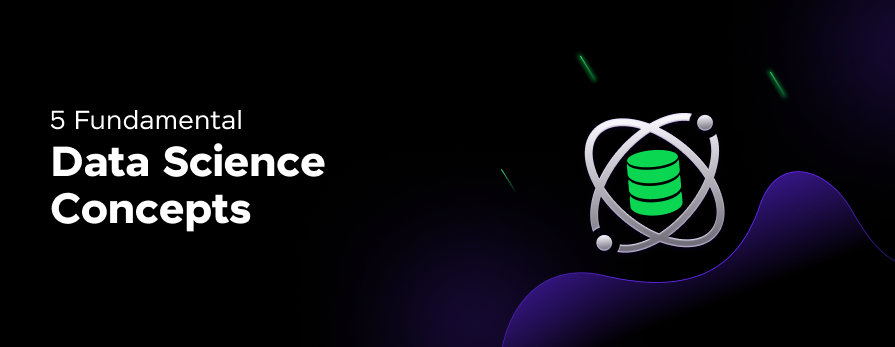
Data science is now at the core of every business in the world, and what does this mean? It means that knowing what it is and its fundamental concepts puts you at a greater advantage out there in the professional world.
Data Science combines statistical analysis, machine learning, and computer science to extract valuable insights from vast amounts of data.
In this article, we will explore the five fundamental data science concepts that form the backbone of this dynamic field. I will take you through all that you need to know about these 5 essential data science concepts, let’s get right to it!
Table of contents
- What is Data Science?
- What Data Science Does:
- Right Skills for Data Science:
- Key Features:
- Top 5 Fundamental Data Science Concepts
- Data Collection and Data Quality
- Exploratory Data Analysis (EDA)
- Statistical Modeling and Machine Learning
- Data Visualization
- Model Evaluation and Validation
- Takeaways…
- FAQs
- What are the core concepts one must understand in data science?
- Can you explain the '5 P's' of data science?
- What constitutes the five key components of data science?
What is Data Science?
Data Science combines several disciplines. It uses statistical methods, machine learning algorithms, and expert knowledge in specific areas to analyze, visualize, and get useful insights from complex data.

This field blends computer-based techniques with traditional statistics to handle large amounts of data, find important patterns, and help make decisions based on data.
What Data Science Does:
- Pattern Recognition: It involves using machine learning models like neural networks and clustering techniques to detect patterns in structured and unstructured data. These patterns are often the backbone of predictive analytics.
- Automation: Automation in data science is achieved through pipelines and models that handle everything from data preprocessing to real-time prediction. For instance, real-time fraud detection in finance uses automated models that flag transactions based on historical data.
- Optimization: Data science plays a crucial role in optimizing business processes by employing algorithms that analyze data to enhance efficiency, such as supply chain optimization using predictive demand forecasting.
Right Skills for Data Science:

- Programming Skills: Python and R are essential for scripting data analysis tasks. Python’s libraries like Pandas, NumPy, and TensorFlow are widely used for data manipulation and building machine learning models, while R excels in statistical analysis.
- Mathematics and Statistics: These form the foundation of most machine learning algorithms. Understanding concepts like matrix operations, eigenvectors (used in PCA), and probability distributions is vital.
- Domain Expertise: This helps in contextualizing data science problems and framing the right questions. For example, in healthcare, domain knowledge is crucial for understanding patient data and building effective predictive models.
- Data Wrangling: This involves transforming messy data into a clean dataset. Techniques include handling missing data (e.g., mean/mode imputation), data transformation (e.g., log transformations for skewed data), and feature engineering (creating new features from existing data).
Key Features:
- Scalability: Data science models must scale with data volume. Techniques like parallel computing using Apache Spark or cloud-based solutions like AWS Lambda are commonly used to process large datasets.
- Adaptability: Data science applications are versatile. For instance, the same clustering algorithm used in customer segmentation can be adapted for image compression tasks.
- Data-Driven Insights: Data science models, such as regression models or decision trees, transform raw data into actionable business strategies by uncovering correlations, trends, and anomalies that are not immediately obvious.
Top 5 Fundamental Data Science Concepts
To excel in data science, you will need to master several key concepts. Given below is a list of five must-know fundamental data science concepts:
1. Data Collection and Data Quality
Data Collection involves gathering raw data from diverse sources, such as relational databases, APIs, and IoT sensors. Data quality is essential as it affects the validity and reliability of the insights derived from data. High-quality data is accurate, complete, consistent, and timely, ensuring that the models built are robust and reliable.

Key Concepts:
- Data Types:
- Structured Data: Data organized in rows and columns (e.g., SQL databases).
- Semi-Structured Data: Data that doesn’t conform to a strict schema but has some organizational properties (e.g., JSON, XML).
- Unstructured Data: Data that lacks a predefined structure (e.g., text files, videos, images).
- Data Acquisition Techniques:
- Web Scraping: Extracting data from websites using tools like BeautifulSoup and Scrapy.
- APIs: Automating data extraction via Application Programming Interfaces, e.g., RESTful APIs.
- Direct Database Queries: Using SQL to extract data from databases efficiently.
- Data Quality Metrics:
- Accuracy: The correctness of data. For instance, ensuring customer addresses are up-to-date.
- Completeness: The dataset must have all necessary attributes. For example, all entries in a dataset should have a value in each required field.
- Consistency: Data should be uniform across datasets. For example, if one dataset uses “USA” and another uses “United States,” they should be standardized.
- Timeliness: Data should be up-to-date. In stock trading algorithms, the data must be real-time to make accurate predictions.
Data Cleaning Techniques:
- Handling Missing Data:
- Imputation: Filling in missing values with statistical estimates such as mean, median, or mode.
- Deletion: Removing records with missing data when the proportion is small.
- Algorithms: Using models like KNN or MICE to predict missing values.
- Outlier Detection:
- Z-Score: Identifies outliers based on the number of standard deviations a data point is from the mean.
- IQR: Identifies outliers based on the interquartile range.
- Anomaly Detection Models: Advanced techniques like Isolation Forests and DBSCAN.
- Normalization and Standardization:
- Normalization: Scales data to a range [0,1], useful when features have different units.
- Standardization: Centers the data by subtracting the mean and scaling by the standard deviation, ensuring a mean of 0 and variance of 1.
Advanced Tools & Techniques:
- ETL Processes (Extract, Transform, Load): Automated workflows for data extraction, transformation, and loading into data warehouses. Tools like Apache NiFi enable real-time data flow management.
- Data Lakes: Repositories for storing vast amounts of raw, unstructured data. Platforms like Hadoop and Amazon S3 allow for flexible data storage and retrieval, suitable for big data analysis.
2. Exploratory Data Analysis (EDA)
Exploratory Data Analysis (EDA) is the process of analyzing datasets to summarize their main characteristics, often using visual methods. It helps data scientists understand the structure of the data, detect anomalies, and identify relationships between variables, guiding further analysis and modeling.

Key Techniques
- Descriptive Statistics:
- Mean, Median, Mode: Central tendency measures that describe the typical value in the dataset.
- Variance and Standard Deviation: Measure data spread, indicating how much the data points deviate from the mean.
- Skewness and Kurtosis: Measure data asymmetry and the peakedness of the distribution, respectively.
- Data Visualization:
- Histograms: Display the frequency distribution of a variable, highlighting data distribution and potential outliers.
- Box Plots: Summarize the distribution of data through quartiles and identify outliers using whiskers.
- Scatter Plots: Show the relationship between two continuous variables, useful for detecting correlations.
- Pair Plots: Display relationships between multiple variables, helping to identify linear/non-linear trends and correlations.
- Correlation Analysis:
- Pearson Correlation: Measures linear correlation between variables, ranging from -1 to 1.
- Spearman Rank Correlation: Measures monotonic relationships, useful when data isn’t normally distributed.
- Heatmaps: Visual representations of correlation matrices, where color intensity indicates the strength of correlation.
Advanced Tools:
- Pandas Profiling: Generates an interactive EDA report with a single command, summarizing statistics, correlations, missing values, and distributions.
- Matplotlib & Seaborn: Python libraries for creating static, animated, and interactive visualizations. Seaborn provides a high-level interface for drawing attractive and informative statistical graphics.
- Plotly & Bokeh: Libraries for creating interactive, web-based visualizations that allow for dynamic exploration of data.
Advanced EDA Techniques:
- Multivariate Analysis:
- PCA (Principal Component Analysis): Reduces the dimensionality of data while retaining the most variance, useful for high-dimensional datasets.
- Factor Analysis: Identifies underlying relationships between variables, grouping them into factors based on common variance.
- Time Series Analysis:
- Trend Analysis: Identifies the long-term direction of a time series.
- Seasonality Analysis: Detects seasonal patterns in data.
- Decomposition: Breaks down time series into trend, seasonal, and residual components to better understand the underlying structure.
Take a rightly paced approach with updated syllabi, tools, and industry-grade projects with GUVI’s Data Science Course brought to you by expert data scientists!
3. Statistical Modeling and Machine Learning
Statistical Modeling and Machine Learning are essential for predictive analytics in data science. These methods allow for the building of models that predict future outcomes, classify data, and uncover patterns in datasets, forming the foundation of data-driven decision-making.

Key Concepts:
- Regression Analysis:
- Linear Regression: Models the linear relationship between a dependent variable and one or more independent variables. It’s widely used for forecasting and trend analysis.
- Logistic Regression: A classification algorithm that models the probability of a binary outcome. Used extensively in applications like email spam detection and medical diagnosis.
- Classification Algorithms:
- Decision Trees: Non-linear models that split data based on feature values, creating a tree-like structure where each branch represents a decision rule.
- Random Forest: An ensemble method that builds multiple decision trees and merges them to improve accuracy and prevent overfitting.
- Support Vector Machines (SVM): Finds the optimal hyperplane that separates classes with the maximum margin, effective in high-dimensional spaces.
- Neural Networks: Complex models inspired by the human brain, consisting of layers of nodes (neurons) that learn to map inputs to outputs through non-linear transformations. Deep neural networks are particularly effective in handling tasks like image and speech recognition.
- Clustering Techniques:
- K-Means Clustering: Partitions data into K clusters where each data point belongs to the cluster with the nearest mean. Used in market segmentation and image compression.
- Hierarchical Clustering: Builds a hierarchy of clusters, starting with each data point in its own cluster and merging them iteratively. Useful for grouping similar objects in taxonomies or customer segmentation.
- DBSCAN (Density-Based Spatial Clustering of Applications with Noise): Identifies clusters based on the density of data points, capable of finding clusters of arbitrary shapes and handling noise (outliers). Ideal for tasks like anomaly detection in credit card transactions.
Modeling Techniques:
- Supervised Learning: Trains models using labeled data. Common algorithms include:
- Linear Regression: For predicting continuous variables.
- Logistic Regression: For binary classification problems.
- Neural Networks: For complex pattern recognition tasks.
- Unsupervised Learning: Used when the data isn’t labeled, typically for clustering and association:
- K-Means Clustering: For customer segmentation.
- Principal Component Analysis (PCA): For dimensionality reduction.
- Semi-Supervised Learning: Combines a small amount of labeled data with a large amount of unlabeled data. Common in image recognition tasks where labeling is expensive.
- Reinforcement Learning: Involves training an agent through trial and error, rewarding desired behaviors. Used in areas like robotics and game AI.
Applications:
- Healthcare: Predictive modeling for patient outcomes using logistic regression, anomaly detection in medical imaging with neural networks, and clustering for patient segmentation.
- Finance: Credit scoring using classification models, portfolio optimization using regression, and risk assessment with clustering techniques.
- Marketing: Customer segmentation with clustering algorithms, predicting customer lifetime value using regression, and recommendation engines using collaborative filtering.
Advanced Tools:
- TensorFlow and Keras: Frameworks for building and training deep learning models. TensorFlow is known for its flexibility and scalability in deploying models to production.
- PyTorch: Another deep learning framework popular in academia and research, known for its dynamic computation graph.
- Scikit-learn: A Python library that provides simple and efficient tools for data mining and data analysis, implementing a wide range of machine learning algorithms.
4. Data Visualization
Data Visualization is the graphical representation of information and data. By using visual elements like charts, graphs, and maps, data visualization tools provide an accessible way to see and understand trends, outliers, and patterns in data.

Visualization Techniques:
- Bar Charts: Used to compare different categories or groups, ideal for categorical data.
- Line Graphs: Display data trends over time, useful in time-series analysis.
- Scatter Plots: Show the relationship between two continuous variables, often used to identify correlations.
- Histograms: Visualize the distribution of a single variable, highlighting the frequency of different ranges of values.
- Heatmaps: Represent data in matrix form, with colors indicating values. Often used to show correlations or geographic data distributions.
Advanced Visualization Tools:
- Tableau: Known for its powerful, interactive data visualizations that integrate with various data sources.
- Power BI: Provides business intelligence and data visualization capabilities, particularly useful for real-time data analysis in enterprises.
- Matplotlib & Seaborn: Python libraries for detailed, customizable visualizations. Seaborn builds on Matplotlib and simplifies the creation of complex plots.
- Plotly: Allows for the creation of interactive plots that can be embedded in web applications, useful for dynamic data exploration.
Applications:
- Business Intelligence: Real-time dashboards for tracking KPIs, sales trends, and financial metrics.
- Healthcare: Visualization of patient data trends, such as the spread of diseases or the efficacy of treatments.
- Marketing: Customer segmentation visualizations using heatmaps, and geographic data visualization for sales distribution.
Visualization Techniques, Tools, and Applications
| Visualization Type | Application | Tools |
| Bar Chart | Comparing categorical data | Tableau, Power BI, Matplotlib |
| Line Graph | Trend analysis over time | Matplotlib, Power BI, Tableau |
| Scatter Plot | Examining relationships between variables | Matplotlib, Plotly, Seaborn |
| Heatmap | Correlation matrix, intensity visualization | Seaborn, Plotly, Power BI |
| Histogram | Visualizing distribution of variables | Seaborn, Matplotlib |
5. Model Evaluation and Validation
Model Evaluation and Validation ensure that a machine-learning model performs well on unseen data. This process involves using various metrics and techniques to assess the accuracy, precision, recall, and other performance indicators, ensuring the model’s generalizability and robustness.

Key Metrics:
- Accuracy: Measures the ratio of correct predictions to the total predictions made, but may not be sufficient for imbalanced datasets.
- Precision and Recall: Precision focuses on the accuracy of positive predictions, while recall measures the model’s ability to capture all actual positives. The F1 score balances precision and recall.
- ROC-AUC: Measures the classifier’s ability across all classification thresholds, with the area under the curve (AUC) indicating model performance.
Advanced Techniques:
- Cross-Validation: Splits the data into multiple folds to validate the model on different subsets, reducing the risk of overfitting. k-fold cross-validation is a popular method.
- Bootstrapping: Repeatedly samples the dataset with replacement to estimate the accuracy and variance of the model.
- Hyperparameter Tuning: Grid Search and Random Search are common methods to find the best model parameters, often coupled with cross-validation.
Tools:
- Scikit-learn: Provides functions for model evaluation, including cross-validation, confusion matrix, and ROC-AUC.
- TensorFlow/Keras: Allows for custom metrics and validation techniques for deep learning models.
- R: Packages like ‘caret’ and ‘e1071’ offer extensive tools for model evaluation.
Applications:
- Finance: Evaluating credit risk models to minimize false positives and false negatives.
- Healthcare: Validating diagnostic models to ensure high precision and recall, critical for patient safety.
- Retail: Assessing recommendation systems to improve user satisfaction by ensuring accurate predictions.
Model Evaluation Metrics and Techniques
| Metric | Definition | Best Use-Case |
| Accuracy | Proportion of correctly predicted instances | Balanced datasets |
| Precision | True Positives / (True Positives + False Positives) | When False Positives are costly |
| Recall | True Positives / (True Positives + False Negatives) | When False Negatives are costly |
| F1 Score | 2 * (Precision * Recall) / (Precision + Recall) | Imbalanced datasets |
| ROC-AUC | Area under the ROC curve | Evaluating classifier performance |
Takeaways…
To wrap up, data science has emerged as a crucial field in today’s data-driven world, combining statistical analysis, machine learning, and computer science to extract valuable insights from vast amounts of information.
Throughout this article, we’ve explored the fundamental concepts that form the backbone of data science, from machine learning and statistical models to data preprocessing and algorithm development.
These core principles provide a solid foundation for professionals looking to navigate the complexities of data analysis and drive innovation across various industries, and I hope that through this article I have been able to help you learn these with ease.
FAQs
To effectively engage in data science, one should have a strong foundation in several key areas:
1. Domain expertise
2. Mathematical or Statistical skills
3. Computer science knowledge
4. Communication abilities
The essential pillars include mathematical expertise, programming abilities, and effective communication.
The ‘5 P’s’ of data science are purpose, plan, process, people, and performance. These elements are crucial for measuring business outcomes, avoiding common pitfalls, and enhancing overall business performance.
The five fundamental components of data science are:
1. Data Collection
2. Data Cleaning
3. Data Exploration and Visualization
4. Data Modeling
5. Model Evaluation and Deployment
Mastery of these components is vital for anyone aspiring to excel in the field of data science.




















![Top 10 Mistakes to Avoid in Your Data Science Career [2025] 10 data science](https://www.guvi.in/blog/wp-content/uploads/2023/05/Beginner-mistakes-in-data-science-career.webp)




Did you enjoy this article?